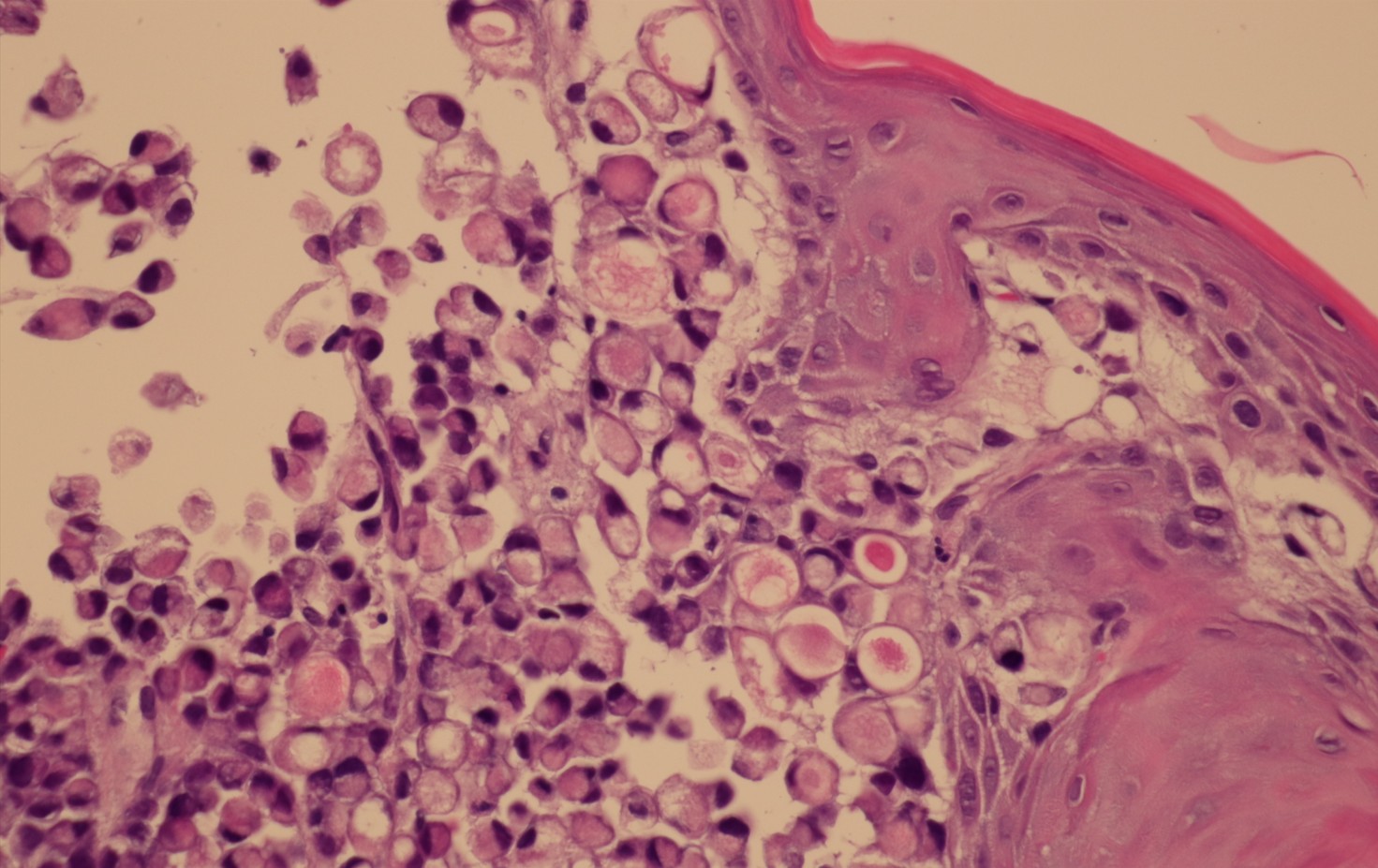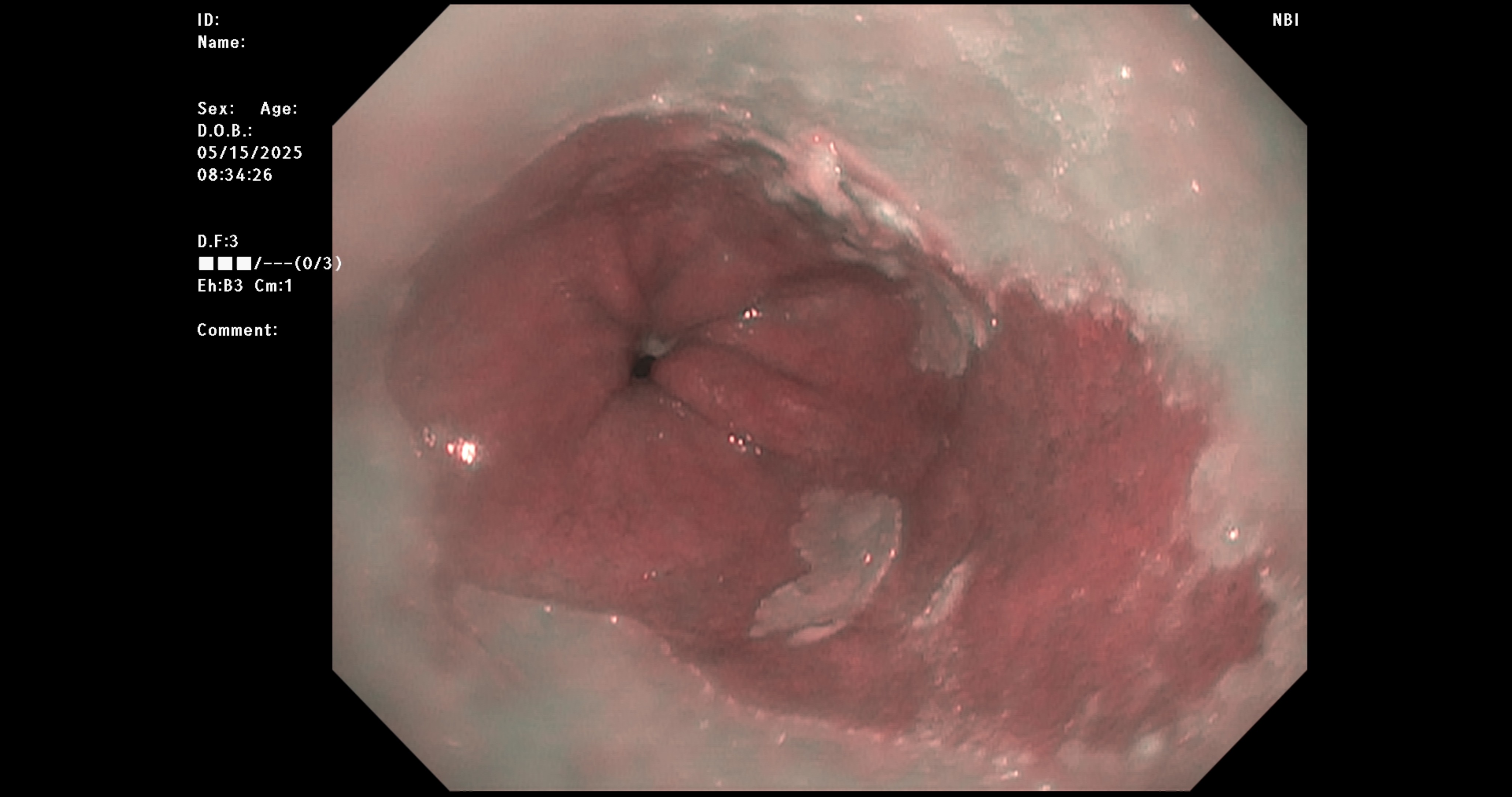Monday Poster Session
Category: Esophagus
P2890 - A Case of Signet-Cell Adenocarcinoma of the Esophagus
Monday, October 27, 2025
10:30 AM - 4:00 PM PDT
Location: Exhibit Hall
- PK
Prem Kurra, MBBS
Apollo Institute of Medical Sciences and Research,Hyderabad,Telangana
St. Louis, MO
Presenting Author(s)
Prem Kurra, MBBS1, Jahnavi Mikkilineni, MBBS2, Sri Sravya L C. Thungathurthi, MBBS3, Akash Reddy Byreddy, MBBS4, Rohith Kode, MBBS5, Harshita Cherukuri, MBBS4
1Apollo Institute of Medical Sciences and Research,Hyderabad,Telangana, St. Louis, MO; 2The Johns Hopkins Hospital, Baltimore, MD; 3Apollo Institute of Medical Sciences and Research, Hyderabad, Telangana, Hyderabad, Telangana, India; 4Apollo Medical College, Hyderabad, Telangana, India; 5Kakatiya Medical College, Warangal, Telangana, India
Introduction: Esophageal Signet ring cell carcinoma (SRCC) accounts for only 2.6–5.0% of all esophageal cancers. SRCC are usually featured by poor differentiation, rapid growth, diffuse infiltration and high metastatic rate. The presence of signet-ring cells conferred a worse prognosis, and these tumors responded differently to conventional treatments as compared with typical adenocarcinoma. We report a case of a 77yr old man diagnosed with signet ring cell carcinoma of the esophagus with history of chronic Barrett’s esophagus.
Case Description/
Methods: A 77-year-old man with a history of Barrett’s esophagus under routine surveillance presented for a scheduled repeat endoscopy. His past medical history included chronic gastroesophageal reflux disease (GERD), asthma, type 2 diabetes mellitus, hypertension, and benign prostatic hyperplasia. Two years prior, an esophagogastroduodenoscopy (EGD) revealed a hiatal hernia and biopsy-confirmed Barrett’s esophagus, for which he was initiated on proton pump inhibitor therapy and advised follow-up surveillance.
At follow-up, the patient reported no new or worsening gastrointestinal symptoms. Endoscopy was done and biopsies were taken from the gastro-esophageal junction which showed a poorly differentiated adenocarcinoma with numerous signet ring cells highlighted by the PAS/Alcian blue stain and a background esophageal junction/fundic mucosa showing areas of intestinal metaplasia. In view of the biopsy results, CT chest, abdomen and pelvis were done to check for metastasis and their results were negative. The patient is currently being considered for esophagectomy due to the poor prognosis associated with SRCC.
Discussion: Esophageal SRCC is a rare aggressive malignancy with a poor prognosis. SRCC is associated with a median range of survival of 10-20 months. The 5-year survival rate drops to 0% in patients having ≥50% signet ring cells on biopsy. It behaves differently from typical adenocarcinoma in response to treatment and are usually diagnosed very late into the disease course. Studies suggest that SRCC’s have a lower rate of complete pathologic response in patients treated with preoperative chemoradiation and surgery. They tend to have more frequent positive margins after resection as compared to other histological types. Recent Nomogram models currently aid in individual risk stratification and prognosis prediction. Further studies are needed to establish evidence-based guidelines for managing this uncommon entity.

Figure: EGD Imaging

Figure: Poorly differentiated signet ring cell carcinoma seen undermining esophageal mucosa
Disclosures:
Prem Kurra indicated no relevant financial relationships.
Jahnavi Mikkilineni indicated no relevant financial relationships.
Sri Sravya Thungathurthi indicated no relevant financial relationships.
Akash Reddy Byreddy indicated no relevant financial relationships.
Rohith Kode indicated no relevant financial relationships.
Harshita Cherukuri indicated no relevant financial relationships.
Prem Kurra, MBBS1, Jahnavi Mikkilineni, MBBS2, Sri Sravya L C. Thungathurthi, MBBS3, Akash Reddy Byreddy, MBBS4, Rohith Kode, MBBS5, Harshita Cherukuri, MBBS4. P2890 - A Case of Signet-Cell Adenocarcinoma of the Esophagus, ACG 2025 Annual Scientific Meeting Abstracts. Phoenix, AZ: American College of Gastroenterology.
1Apollo Institute of Medical Sciences and Research,Hyderabad,Telangana, St. Louis, MO; 2The Johns Hopkins Hospital, Baltimore, MD; 3Apollo Institute of Medical Sciences and Research, Hyderabad, Telangana, Hyderabad, Telangana, India; 4Apollo Medical College, Hyderabad, Telangana, India; 5Kakatiya Medical College, Warangal, Telangana, India
Introduction: Esophageal Signet ring cell carcinoma (SRCC) accounts for only 2.6–5.0% of all esophageal cancers. SRCC are usually featured by poor differentiation, rapid growth, diffuse infiltration and high metastatic rate. The presence of signet-ring cells conferred a worse prognosis, and these tumors responded differently to conventional treatments as compared with typical adenocarcinoma. We report a case of a 77yr old man diagnosed with signet ring cell carcinoma of the esophagus with history of chronic Barrett’s esophagus.
Case Description/
Methods: A 77-year-old man with a history of Barrett’s esophagus under routine surveillance presented for a scheduled repeat endoscopy. His past medical history included chronic gastroesophageal reflux disease (GERD), asthma, type 2 diabetes mellitus, hypertension, and benign prostatic hyperplasia. Two years prior, an esophagogastroduodenoscopy (EGD) revealed a hiatal hernia and biopsy-confirmed Barrett’s esophagus, for which he was initiated on proton pump inhibitor therapy and advised follow-up surveillance.
At follow-up, the patient reported no new or worsening gastrointestinal symptoms. Endoscopy was done and biopsies were taken from the gastro-esophageal junction which showed a poorly differentiated adenocarcinoma with numerous signet ring cells highlighted by the PAS/Alcian blue stain and a background esophageal junction/fundic mucosa showing areas of intestinal metaplasia. In view of the biopsy results, CT chest, abdomen and pelvis were done to check for metastasis and their results were negative. The patient is currently being considered for esophagectomy due to the poor prognosis associated with SRCC.
Discussion: Esophageal SRCC is a rare aggressive malignancy with a poor prognosis. SRCC is associated with a median range of survival of 10-20 months. The 5-year survival rate drops to 0% in patients having ≥50% signet ring cells on biopsy. It behaves differently from typical adenocarcinoma in response to treatment and are usually diagnosed very late into the disease course. Studies suggest that SRCC’s have a lower rate of complete pathologic response in patients treated with preoperative chemoradiation and surgery. They tend to have more frequent positive margins after resection as compared to other histological types. Recent Nomogram models currently aid in individual risk stratification and prognosis prediction. Further studies are needed to establish evidence-based guidelines for managing this uncommon entity.

Figure: EGD Imaging

Figure: Poorly differentiated signet ring cell carcinoma seen undermining esophageal mucosa
Disclosures:
Prem Kurra indicated no relevant financial relationships.
Jahnavi Mikkilineni indicated no relevant financial relationships.
Sri Sravya Thungathurthi indicated no relevant financial relationships.
Akash Reddy Byreddy indicated no relevant financial relationships.
Rohith Kode indicated no relevant financial relationships.
Harshita Cherukuri indicated no relevant financial relationships.
Prem Kurra, MBBS1, Jahnavi Mikkilineni, MBBS2, Sri Sravya L C. Thungathurthi, MBBS3, Akash Reddy Byreddy, MBBS4, Rohith Kode, MBBS5, Harshita Cherukuri, MBBS4. P2890 - A Case of Signet-Cell Adenocarcinoma of the Esophagus, ACG 2025 Annual Scientific Meeting Abstracts. Phoenix, AZ: American College of Gastroenterology.
